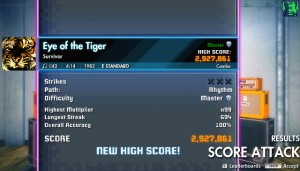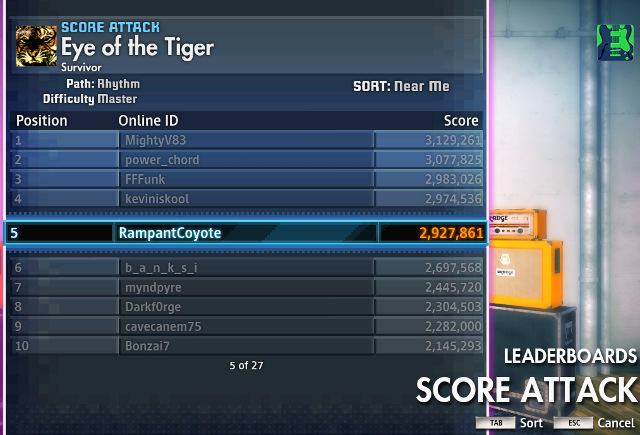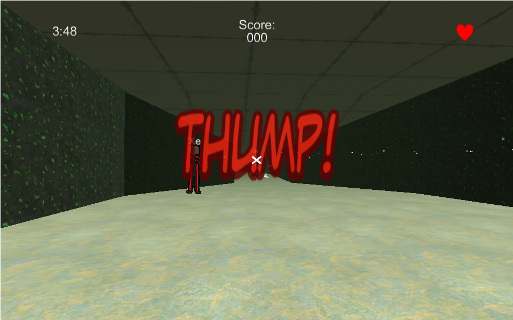RPG Design: Random Starts, and Playing Weaknesses
Posted by Rampant Coyote on May 20, 2014
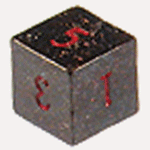 3D6. For those unfamiliar with dice-and-paper gaming, that means rolling three standard 6-sided dice, and adding their values together.
3D6. For those unfamiliar with dice-and-paper gaming, that means rolling three standard 6-sided dice, and adding their values together.
Back in the old days of D&D, that was how your character was created. 3D6 created ability scores, from a range of 3-18, with 10 being defined as “average.” In the most hardcore tradition, you rolled six sets of scores and assigned them to your character in the order in which they appeared, giving you a completely random character. Then you’d pick a class your character might qualify for (with a ‘fighter’ — or ‘fighting-man’ — really having no qualifications necessary) and off you go. If your character was truly pathetic, you might hope to have ’em die quickly so you could create another character. Creating a new character in old-school D&D took only a few minutes, so it wasn’t a big deal.
At some point, people decided that those who took the adventuring lifestyle ought to be at least somewhat better than your average pig-keeper (never mind that heroic fantasy does have a place for even assistant pig-keepers), and opted for more generous probabilities, and the ability for a player to choose which scores went to which abilities. In the AD&D days, the preferred method was to roll four six-sided dice for each score, but to ignore the value of the lowest die. This still yielded scores in the 3-18 range, but with a higher average, and it was still possible to get a really weak score in one or two abilities.
D&D – and most other game systems – eventually moved away from randomized stats in favor of “point buy” systems. Players no longer needed to fear a bad set of dice rolls! While it sounds great on the surface, the problem is that player characters all end up with very similar sets of stats, min-maxed for their chosen specialty or class (and if it’s a classless system, it’s even worse).
The problem is that it’s hard for players to voluntarily play weaknesses. Maybe it’s part of the dividing line between narrative and game raising its ugly head again: Overcoming weaknesses (or succeeding in spite of them) makes for a great story, but even in a non-competitive game, people don’t like being saddled with a disadvantage out of the starting gate.
The old random generation system forced the issue. You were almost always guaranteed to have a character with something awesome, like a 16 and a 17, but have a 5 somewhere else. And admittedly, playing a complete weakling or an imbecile can get tiresome after a while, and modern games don’t have the rapid character turnover (read: high character mortality rates and rapid character generation) of the original D&D.
Of course, modern systems do try to encourage players to take weaknesses. With point-buy, you can get a higher top stat if you accept a lower weak stat. Or, in some systems, you can take a character disadvantage in exchange for extra build points. But these, too, tend to get min-maxed, and only very rarely will players voluntarily take a serious disadvantage, opting instead for those weaknesses that are either very minor or have a low probability of affecting them in any dangerous way.
Again, this runs contrary to what makes a good narrative. It’s always more exciting to cheer the underdog, not the guy who has all the advantages. It’s also fun to start with a character that isn’t completely under your control, as it encourages you to adapt your play-style a little bit, think a little bit outside the box, and come up with a custom personality (in tabletop gaming) to match.
So while I don’t mind that the hard-core, purely random character generation remains an artifact of the oldest of old-school RPGs (and a few modern Roguelikes), there were definitely some advantages. I’d like to see more games experimenting with ways to bring us the best of both worlds.
Filed Under: Design - Comments: 10 Comments to Read
What Is Steampunk (to me)?
Posted by Rampant Coyote on May 19, 2014
 I do not have a “steampunk” game in development right now (but I do have a few ideas I’d love to explore in the future). My short story, “Dots, Dashes, and Deceit” is being released in the anthology Terra Mechanica: A Steampunk Anthology in two weeks. I love the subgenre, and I thought I’d try to explain why.
I do not have a “steampunk” game in development right now (but I do have a few ideas I’d love to explore in the future). My short story, “Dots, Dashes, and Deceit” is being released in the anthology Terra Mechanica: A Steampunk Anthology in two weeks. I love the subgenre, and I thought I’d try to explain why.
That’s my family on the right, in full steampunk regalia. The photography studio was pretty thrilled to shoot our family photos. Believe it or not, I was not the instigator here. Two years ago, my family dragged me to a local steampunk convention (Salt City Steamfest). I was not very interested. I was only there for one afternoon / evening, and the air conditioning at the convention center was not keeping up with the large number of people at all. I had to step outside into 92-degree weather to cool down. Yes, it was that bad.
But I still loved it. I attended a few of the more academic panels, and had a great time. Most people there are probably there just because of the fun deviations on Victorian-era costumes, and the overall aesthetic. That’s all cool and fun, but I was inspired by the storytelling possibilities.
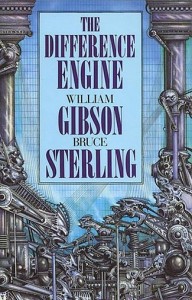 Backing up a little further… The first real “steampunk” novel I read was before it was a “thing.” It was The Difference Engine, by William Gibson and Bruce Sterling. While the storytelling wasn’t the greatest IMO (I’ve liked several novels by the authors individually, but this one didn’t thrill me as much), the concept was really cool. What if Babbage had managed to complete his Analytical Engine, and the Information Age came about by the mid 19th century instead of the mid-late 20th century? The novel explored some pretty cool “what ifs” – many of which revolved around what could possibly go wrong if the greatest imperialist nations of all time got its hands on that kind of technology. It considered the social and political ramifications, and seemed like a rich backdrop for a thousand fascinating stories.
Backing up a little further… The first real “steampunk” novel I read was before it was a “thing.” It was The Difference Engine, by William Gibson and Bruce Sterling. While the storytelling wasn’t the greatest IMO (I’ve liked several novels by the authors individually, but this one didn’t thrill me as much), the concept was really cool. What if Babbage had managed to complete his Analytical Engine, and the Information Age came about by the mid 19th century instead of the mid-late 20th century? The novel explored some pretty cool “what ifs” – many of which revolved around what could possibly go wrong if the greatest imperialist nations of all time got its hands on that kind of technology. It considered the social and political ramifications, and seemed like a rich backdrop for a thousand fascinating stories.
So then, a couple of decades later, my family is into this thing, which I think is mildly interesting, but I am not paying much attention. Meanwhile, I’m complaining here on the blog and other places about the relative dearth of alternative settings in things like role-playing games. Why are we stuck in Tolkien-esque worlds so much? Surely we can go beyond pseudo-medieval eras and still be successful, right? What else is there?
Then I get dragged to Salt City Steamfest, and a lightbulb turned on in my head – probably one of the impractical, pre-Edison light bulbs.
Steampunk is basically speculative fiction set in a world roughly analogous to our own around the time of Queen Victoria – think mid 1800s up to about World War I. That sounds simple enough, yet there are a lot of critics who try to narrow things down – particularly emphasizing the “punk” aspect of the term, necessitating social commentary rolled into the genre. The way I figure it – it’s kinda like the term “role-playing game” – it’s more of an inaccurate marketing term stamped on the category after the fact. (In jest, actually…) I don’t want to go too far with making that an exclusionary term.
Instead, the light-bulb that went off for me was about the wild, exciting flights of fantasy that could take place within this concept. It has the advantage of being relatively well-understood era today… more familiar to most people than the medieval era where most fantasy takes place. We’ve got photographs, family stories, and we haven’t quite lost everybody who was born in that age. It’s also an era that kinda brought us modern science fiction, with the works of H.G. Wells, Jules Verne, Edgar Allen Poe, and (a little earlier) Mary Shelley’s Frankenstein. Fun stuff!
 Since none of what would have been “science fiction” in that time period actually came to pass (at least not in the form it was envisioned), it could be considered “fantasy” today. That was kind of a liberating idea… someone could tell a science-fiction story set in the past, and it really becomes fantasy, and thus is freed from any temptation to be plausible. Of course that technology wouldn’t work! Who cares? A necromancer with a zombie army never led an assault against against the British Parliament in 1875, either, but who cares? That all fits.
Since none of what would have been “science fiction” in that time period actually came to pass (at least not in the form it was envisioned), it could be considered “fantasy” today. That was kind of a liberating idea… someone could tell a science-fiction story set in the past, and it really becomes fantasy, and thus is freed from any temptation to be plausible. Of course that technology wouldn’t work! Who cares? A necromancer with a zombie army never led an assault against against the British Parliament in 1875, either, but who cares? That all fits.
That was what it was for me – this willingness for steampunk to go balls-to-the-wall crazy by mixing whatever the hell they wanted into a loosely-defined time period and have fun with it. Let me put a bigger emphasis on that last phrase: have fun with it. I got into science fiction and fantasy as a kid because it was fun. It was escapist. Sure, it got serious, it made me think and reflect, it may have carried a “message” or two thinly veiled within metaphors. I’d go on these journeys to impossible worlds, and sometimes come back with something real – a new perspective about life, or people, or a willingness to think about things from a different perspective. But that was a secondary benefit. I went there – in books or games – because it was fun. A little vacation from reality.
I’ve usually enjoyed the blend of subgenres and historical eras in my science fiction and fantasy – from modern-era “urban fantasy” to pirates and musketeers fighting dragons and vampires. Steampunk, for me, was kind of the golden spike pulling it all together and connecting anything. It wasn’t just about 75-year-ish setting for speculative fiction. It was a reminder to let my inner child free and go nuts. From there, you can get all kinds of permutations and derivatives that can be equally fun. Retro-futuristic? Dieselpunk? Atompunk / Raygun Gothic? Weird West? Urban fantasy? Cyberpunk? It’s all good.
I come from the Star Wars generation, which had “knights” who acted like wizards wielding magical swords side-by-side with robots and spaceship pilots against laser-wielding soldiers, monsters, and walking tanks. Maybe that’s why, deep inside, the idea of coloring outside the genre lines sounds like fun to me. Speculative fiction doesn’t deserve to be be constrained by tiny boxes labeled with marketing terms. The definitions are just an attempt to make it possible to talk about this stuff. Mix and match to your hearts’ content, boys and girls. Life is too short to be a purist.
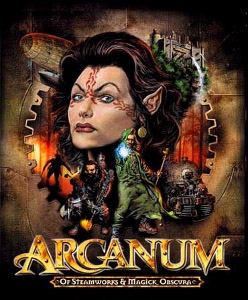 From the computer /console role-playing games side of things, I think the Final Fantasy series has always been a strange, alien blend of technology and magic. Arcanum: Of Steamworks and Magick Obscura by Troika Games was a more focused “steampunk” offering. I love the approach… they simply took what would have been a standard, run-of-the-mill fantasy world, with your usual elves, dwarves, orcs, gnomes, wizards, and so forth – and advanced it a few hundred years in technology and culture so that it kinda-sorta mirrored that of the Victorian era. Bastion would probably count. While not really an RPG, the Thief series – originally by Looking Glass – would qualify, though it has a bit more of a medieval aesthetic. Telepath RPG: Servants of God also has a bit of a steampunk aesthetic, but with a strong Middle-Eastern influence.
From the computer /console role-playing games side of things, I think the Final Fantasy series has always been a strange, alien blend of technology and magic. Arcanum: Of Steamworks and Magick Obscura by Troika Games was a more focused “steampunk” offering. I love the approach… they simply took what would have been a standard, run-of-the-mill fantasy world, with your usual elves, dwarves, orcs, gnomes, wizards, and so forth – and advanced it a few hundred years in technology and culture so that it kinda-sorta mirrored that of the Victorian era. Bastion would probably count. While not really an RPG, the Thief series – originally by Looking Glass – would qualify, though it has a bit more of a medieval aesthetic. Telepath RPG: Servants of God also has a bit of a steampunk aesthetic, but with a strong Middle-Eastern influence.
That’s just scratching the surface, of course. Particularly in the indie space, there are steampunk-themed games coming out pretty frequently. I haven’t checked them all out yet (I wish!), but it’s exciting to see some of the variety.
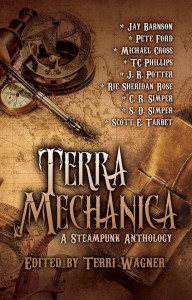 As I mentioned last week, my first foray as a published fiction writer is coming out in an anthology at the end of the month. My story, Dots, Dashes, and Deceit, is part of an anthology called Terra Mechanica: A Steampunk Anthology. The theme of the anthology was world travel, so there aren’t any stories stuck in Victorian London. So much for genre purist expectations!
As I mentioned last week, my first foray as a published fiction writer is coming out in an anthology at the end of the month. My story, Dots, Dashes, and Deceit, is part of an anthology called Terra Mechanica: A Steampunk Anthology. The theme of the anthology was world travel, so there aren’t any stories stuck in Victorian London. So much for genre purist expectations!
I will have more information and links soon. But hey, it has a Goodreads entry now!
So now, if you catch me going off on steampunk-related discussions in the future, you know why.
As always, folks… have fun!
Filed Under: Books, Design - Comments: 5 Comments to Read
Rocksmith 2014 – The Sixth Month Report
Posted by Rampant Coyote on May 16, 2014
 The nature of a game like Rocksmith 2014 is such that you can’t get a good evaluation based on just a couple of weeks of play, like most review schedules. To really learn whether or not it does what it claims, it’s after the shiny newness has worn off, and it’s become old news.
The nature of a game like Rocksmith 2014 is such that you can’t get a good evaluation based on just a couple of weeks of play, like most review schedules. To really learn whether or not it does what it claims, it’s after the shiny newness has worn off, and it’s become old news.
The goal of the game is to teach the player to play guitar – for real. It was an answer to the complaints during Guitar Hero‘s heyday that if players had focused as much energy into learning to play the real guitar as mastering a plastic controller, they’d have become a skilled guitarist by then. Rocksmith 2014 tries to fill that role, and its sequel advertised itself as “the fastest way to learn guitar.” The guitar isn’t something you learn in a couple of weeks, no matter how accelerated the process might be.
As a quick TLDR conclusion – I don’t think my opinion of the game has changed much from my Sixty Days of Rocksmith 2014 article four months ago. Sixty days was enough time to see some clear progress and get a good feel for how the game worked, but I thought that after half a year – even at fairly moderate practice levels – I would get a clearer picture. Honestly, nothing revelatory happened. I am still making slow, consistent progress. The game hasn’t suddenly become 10x better or useless for me – it’s strengths and weaknesses remain, and I’m still having fun gaining competence.
So – I have been playing the game for six months now, for an average of only 45 minutes a day. Here’s how it’s gone for me.
Starting Point
I can’t say I started out as a total newbie – I’ve been in the zone between “beginner” and “intermediate” for many, many years. I could play some open chords and 2 or 3 string power chords pretty easily (though I would be hard pressed to know what I was playing by note… I’d still have to count steps / frets). I couldn’t play a full song by memory (I tried once with I Love Rock & Roll, years ago, and had to simplify even something that simple to pull it off). My timing was all over the place, and transitioning between chords was usually pretty slow. Unless I really tried at it, my strumming was all downstrokes.
In my own estimation, the building blocks that a beginner must learn were there, but had ossified, and bad beginner habits (of which I’m sure I still have plenty) had become long-ingrained. When people asked if I played a musical instrument, my answer was “no.” I played with a guitar, but I didn’t really play it.
Even the skills I had were something of an improvement from four years earlier. I think I enjoyed more extended practice via Rocksmith and Rock Band 3 Pro Mode than I usually put in during any previous year for a long, long time. My progress was not great, but I think I managed to dust off my old skills and get a little bit of a feel for what it really meant to play guitar again.
Now – to be fair – with my newfound practice regime and enthusiasm about seeing actual progress, I didn’t restrict myself exclusively to Rocksmith 2014. I found some additional instruction on the web. I sometimes practice “unplugged” with my acoustic guitar. And I admit, 45 minutes a day isn’t going to turn me into a virtuoso in my lifetime. I don’t harbor any secret beliefs that I’m going to switch careers to “rock star.” I just want to be able to actually play guitar, and play it competently.
How Far I’ve Come
Rocksmith 2014 offers plenty of gauges to view your progress within the game. Whether it’s a mastery or accuracy number for a particular song in “Learn a song,” or a mastery level for the lessons with practice tracks, or the more artificial scores in the “Guitarcade” technique games or Guitar Hero-like “Score Attack” modes, you can see how much you are doing better with every exercise and session. That’s cool. Of course, what really counts is how well you can play “unplugged.” RS 2014 is still not perfect in its accuracy – it tends to err on the side of “false positives” – allowing notes and chords that are really, really sloppy far more often than failing good playing, but it still has a bit of both. You really have to listen to yourself. But the scoring is a decent proxy if you aren’t trying to “game” it.
One nice thing about the Score Attack, by the way, is that the score will reflect your timing, unlike “Learn a Song.” So while you might be good enough to have it “pass off” your playing, you’ll get a lower score on Score Attack if you are late or early. Unfortunately, this is a little more challenging with the latency issues – getting “perfect” is a lot harder than it should be – though there are adjustments to compensate. I think on a faster machine, I’d have less problems.
Scales
In the last six months, I’ve learned new scales – particularly the blues scale and phrygian dominant scale, which are really fun. I’m not quite to the point of having memorized them all over the fretboard yet – I’m still working on that. But for a guy who spent twenty years never going beyond the pentatonic minor, it feels like an improvement.
Achievements
I’m earned two-thirds of the achievements on Steam for the game, including almost all the ones I care about. The remaining ones are mostly Guitarcade technique game scores (I’ve only earned one of those), and some completionist items. I actually tried to earn one of the “secret” achievements – failing a song in Score Attack ten times, but on the sixth or seventh try I actually passed it off. The song was “Ballroom Blitz.” The weird thing is, I hadn’t gone through the full “Learn a song” cycle for that song yet. I learned it by failing it in Score Attack – Hard Mode – several times. So hey – the old Guitar Hero method of mastering a song *does* work.
Anyway, achievements don’t automagically equate to progress, but I don’t think they are completely uncorrelated.
Did I Outgrow My Guitar?
I’ve had an old, very low-end Squier Fender for years. It was an upgrade over an ancient Asian plywood thing that was as old as me that I bought in a pawn shop for $50 when I was 16 years old. A couple of months ago, I began to realize that I was running into the limitations of the guitar itself. That was kind of novel. It wasn’t major, but playing the guitar clean had some annoying little artifacts that new strings, adjusting the intonation, and careful playing just couldn’t fix.
 So I bought a new guitar. My upgrade wasn’t that major – it’s still not an expensive guitar, but it’s a decent step or two above the old one. I had a few very specific requirements. I wanted 22 frets instead of 21, and – just because! – a tremelo (“whammy”) bar. After a *lot* of research, reading tons of reviews, visits to the guitar store, and watching YouTube videos, I settled on a “raspberry red” Yamaha Pacifica 112V. For it’s price range, it’s really hard to beat. For a couple hundred dollars more, I could get a mid-level Squier Classic Strat, which is of comparable quality but has the genuine “strat” tone. While that’s an awesome tone, I decided on the Pacifica instead. It has an alder body, maple neck, three decent quality alnico V pickups, a 5-way switch, 22 frets… and the whammy bar (sadly, not a great one, but I don’t intend to use it that much). The bridge pickup is a humbucker, which is good for higher distortion playing and has a clean, mellow tone. But – a nice feature of the Pacificas – the tone knob can be pupped up to a new position to cut off one of the coils, and convert it into a single-coil for more of a bright, “crunchy” tone.
So I bought a new guitar. My upgrade wasn’t that major – it’s still not an expensive guitar, but it’s a decent step or two above the old one. I had a few very specific requirements. I wanted 22 frets instead of 21, and – just because! – a tremelo (“whammy”) bar. After a *lot* of research, reading tons of reviews, visits to the guitar store, and watching YouTube videos, I settled on a “raspberry red” Yamaha Pacifica 112V. For it’s price range, it’s really hard to beat. For a couple hundred dollars more, I could get a mid-level Squier Classic Strat, which is of comparable quality but has the genuine “strat” tone. While that’s an awesome tone, I decided on the Pacifica instead. It has an alder body, maple neck, three decent quality alnico V pickups, a 5-way switch, 22 frets… and the whammy bar (sadly, not a great one, but I don’t intend to use it that much). The bridge pickup is a humbucker, which is good for higher distortion playing and has a clean, mellow tone. But – a nice feature of the Pacificas – the tone knob can be pupped up to a new position to cut off one of the coils, and convert it into a single-coil for more of a bright, “crunchy” tone.
And I like the look of it. It’s a sexy guitar.
Most importantly – it made a difference. Not a huge difference, but for my scores that were in the 90%+, particularly the ones with lots of strumming of full-ish chords, my scores really improved overnight. So… maybe I just bought a very expensive game controller, but I do love it, and there’s some evidence that yes, I really was being limited by the old guitar. Sometimes. But getting good enough that the guitar seemed to make a difference was… well, cool.
I have only done it with one song – and then, still not consistently – but I’ve managed to get 100% accuracy in a song at full difficulty. Or – in this case – on “Master” difficulty in Score Attack – which is the mode where you have to play the entire song from memory. So while I still can’t play it perfectly (more on that a little later…), it was fun to get the “Perfectly Perfect Game” achievement for this particular run. But while Eye of the Tiger by Survivor isn’t the most challenging song in the world, being able to nail it from memory close enough for RS2014 to count it as 100% was something that was absolutely unthinkable six months ago.
Learning New Songs is Easier
This is a delightful discovery. While there are still some songs that feel “beyond me,” I’ve found that learning a new song is generally far, far easier than it used to be, and that I very quickly ramp up the auto-scaling difficulty to a pretty high (if not maxed out) level. From a common-sense perspective, this is logical, but emotionally my internal dialog was something like, “Oh, man, I’ve played this song for WEEKS and I’m still not very good at it! How can I ever learn even a dozen songs at this rate?!?!?” This means that the skills, the muscle-memory, the pattern-recognition, and all that fun stuff is starting to set in place. In fact, I find that for some songs, my fingers can subconsciously “guess” where the next position / chord will be the first time I’ve played the song (assuming I’ve heard the song before). They aren’t always right, but they are often in the right neighborhood.
Leaping Over the Old Plateaus
Another “ah-hah” moment came a few times when I gave up on certain songs weeks or months before because I’d just hit a plateau and couldn’t seem make anything more than tenths-of-a-percentage improvements no matter how hard I tried. After several weeks, never having practiced the song again even once, I played it cold (sometimes re-enabling the ‘mastered’ sections because I couldn’t remember it), and blew away my previous score! And then, on the second try, kicking it up another couple of notches!
Like learning new songs more easily, this tells me that yes, my underlying skills have increased.
Leaderboard Positions!
Okay, sometimes it’s really fun to be a big fish in a small pond. And the pond is small – this is for playing Rhythm (Lead is far more popular, duh), on the PC leaderboards (probably smaller than the ones for the consoles), for songs that were originally Rocksmith 1 DLC (but compatible for RS2014). But hey – still, I’m in the top five in the world on both songs… one in “Hard” mode (maximum difficulty) for White Wedding, and one in “Master” mode (maximum difficulty, but played from memory).
Now – a little bit more on this… I scored 100% accuracy, but there are still four people with higher scores than me. Why? That’s because there are degrees of success. Even though I hit the right(ish) notes, Score Attack also scores based on timing accuracy. So I could be 100% accuracy but have my timing off (and as you can see in the video, my timing is often off), and not get the points the people above me did for nailing the timing perfectly and consistently.
Multiplayer Coolness!
This isn’t really a reflection of my own improvement, but I finally got to play the game multiplayer – with my daughter. She hadn’t played the game before, but learned quickly (she plays an acoustic guitar, probably better than I did a year ago…). We had a lot of fun, and I was actually able to show her some tricks and teach her a few things… not just Rocksmith-related! And being able to learn a new song together – and not sound too terrible playing a duet together with the music backing us – was just cool beyond all words. Plus goofing around in Session Mode in something of a jam was cool. But really – playing with other people is cool beyond words. DUH. Not a revelation to any musician, I know, but still… it’s awesome that RS2014 does this so well. It’s another cool motivating factor.
And Finally…. Here’s Me Playing Something I Couldn’t Six Months Ago…
The proof, ultimately, is in simply playing the guitar. So here’s my little performance of the song that I play best. This isn’t my best performance, and FRAPS screws things up a little and monkeys with the frame rate, and my timing could have been better, and… <excuse> <excuse> <excuse>. Okay. I’m not quite ready to play in a band yet. But recognizing that back in October, I couldn’t really play anything except a few simple chords… this is Progress with a capital P. In the mixer, I turned down the music level so my guitar – and all my mistakes and bad timing – would be clearly front-and-center. So if at any time you can’t tell that it’s not just the original song playing — that’s a rare moment of me being awesome.
I may not yet be able to play very well, but I can definitely play guitar now.
Conclusion
I refer you to my article on Eleven Tips to Getting the Most Out of Rocksmith 2014. That’s pretty much how I’ve been using the game. It’s not a perfect tool, but it is a really entertaining way to help you practice, learn songs, and gauge your improvement. If you take advantage of what it has to offer, but are cognizant of its limitations and find ways to work around those or supplement your experience, it’s awesome. Is it the fastest way to learn guitar? Heck if I know. I just know that I’ve really had fun and made a lot of progress over the last six months. I’m not totally competent at the guitar, but I expect that’s something that comes with years, not weeks or months.
There are definitely some areas where Rocksmith 2014 can improve. Its accuracy and latency have greatly improved since the first game, but could still be better. I’d love to have the ability to record and play back your performance from directly within the game. The first game could do that (kinda), so I don’t know why they dumped it. And it could absolutely use some more big-hair 80’s metal. I’m just sayin’.
I think my commitment to practice was the biggest factor in my progress. I turned it into a habit, and that’s been awesome. Would I have made the same progress without the game, putting in the same time using tabs and online instruction? I don’t know, but I actually don’t think so. It certainly wouldn’t have been as fun. The game is really open and lets you practice how and what you want, but it provides you with a ton of “hooks” to motivate you, help you measure your progress (a huge motivating factor for me – I hate getting ‘stuck’), and provides some decent (if imperfect) feedback.
It’s not the only tool you’d need, but if you want to learn rock guitar, I’d recommend it in a heartbeat.
Filed Under: Guitar Games - Comments: 5 Comments to Read
Indies, Evangelism, Tour Guides, and the Chatuchak Market
Posted by Rampant Coyote on May 15, 2014
 I was a cheerleader for the glut.
I was a cheerleader for the glut.
Back when indie games – as a whole – needed the attention because the mainstream titles were hogging the spotlight, I called myself an “indie evangelist.” I was a cheerleader for the indie revolution, in my own small way. We, the indies, were going to break the shackles of the mainstream game industry! No longer would game developers be cut off from their customers by the industry gatekeepers! No longer would customers be limited to a tiny cross-section of committee-designed, boardroom-approved, mass-market-optimized Pablum. No, the games of the indie revolution would be quirky, weird, niche, cool, innovative, rough, raw, and sometimes downright dangerous. A new golden age!
And here we are. The gold-paved roads (or at least gold-plated) of the brave new world are worn and covered with crap from a thousand new horses, mules, cows, chickens, and oxen every day. The industry has seen what happened to iOS, and see the same thing happening on Steam. And the weird, cool, niche little titles that couldn’t be made back in the old days simply cannot be found today. While they might be of decent quality, they are too often buried at the bottom of the river of crap.
And now many indies – particularly the ones from the pre-glut days, the ones who made some serious success by making it on certain platforms (like Steam) when it was new or rare – are getting a little grumpy about it. Their sales – or particularly their new titles – are struggling. And the folks trying to put out a decent game find themselves undercut by titles that are selling for not quit a dime a dozen, but often a half-dozen for less than three bucks in one of the tons of bundle deals.
I look at this situation, and I think, “Is this what I was cheering for? Is this what I was hoping for? This is my libertarian paradise, at last. Few barriers to entry, and a no-holds-barred free-for-all in the marketplace, where the survivors are… not usually the ones I would have chosen.”
Granted, going from “never even getting made” to “getting made but hardly selling” is something of a step up in the world. Many of my favorite games come from the ragged edge of the long tail, although I doubt that appreciation is enough to appease the developers who now have to figure out some way to pay off the debt incurred by the development of their game that only sold thirty-six copies.
And of course, it’s not just games. Books. Music. Even movies. The restrictions imposed by the technology of the last couple of centuries have been removed, and the business models that developed around the drastic economies of scale may have not crumbled completely, but they are definitely showing the cracks in their foundation. Welcome to the new world of media!
While my own role was small, I was one of the many, many hands opening Pandora’s Box, and one of the many voices cheering it on. Go indie! And now we have a glut. A truly amazing glut. It’s not just games, of course. The publishing industry is going through this right now, and is having just as hard a time of it. The word words “transitionary period” and “change” and “confusion” and “unknown” are frequently used to describe all this. How will it end up?
A couple of years ago, I was able to visit the Chatuchak Weekend Market in Bangkok, Thailand. Seriously, it was an amazing place. I have no idea how many stalls there were, but I almost got lost. We’re talking row upon row of dozens and dozens of stalls. I read that there are 15,000 stalls. This puts the biggest American mega-mall I ever visited to shame. If you didn’t know what you were looking for, you’d probably find it. You’d find something. I found tons of gifts for friends and family members. But if you were looking for something more specific – like a funny T-shirt to fit a tall American male… you might be out of luck. A lot of the vendors sold pretty much the same wares, at pretty much the same price. I don’t know how a vendor is supposed to run a profitable stall in the Chatuchak market, short of placement near the entrance. Perhaps there are guidebooks for the market – I can’t remember. I didn’t have one.
I think it would suck being one of the vendors sitting in the middle of the market, selling nothing but the same thing that a hundred other vendors sold. Or something so similar that it seemed indistinguishable to the average customer. Maybe they’ve figured out ways to drive extra traffic to their stall. But most of them… don’t.
All I can say is that I don’t want to be a vendor at Chatuchak. It’s kind of fun to enjoy the sensory overload as a customer there at least once, but it wouldn’t be a place I’d go shopping regularly, either.
Right now, if you are searching for fiction of a particular genre at Amazon, it’s starting to look a lot like the Chatuchak Market. Applications on the iOS App Store and Google Play stores are already there, and have been for a while. Steam is starting to get there with PC games. Placement and popularity on those sites are a lot like having a shop near the entrance at Chatuchak – it’s where most of the traffic is going to go. People will either already find what they want, or give up and go home long before they delve into the furthest reaches of the market.
I have a tough time with the term “curator.” It makes me think of stuffy museum curators (though I know plenty who aren’t at all stuffy) who pick and choose what the public can see in a sterile environment. I worry that the power of peer pressure will result in a whole lot of curators choosing the same things in an echo-chamber of official approval. The problem with that is that they pick the winners and the losers. You can only see what they curate, or go to another curator. Granted, that’s effectively how it works, but by default, I think that’s where we’ll be going. But I still have this irrational love for the wild, free, no-holds-barred, sometimes weed-choked openness of the grand old self-published, self-funded wilderness of indie-dom.
From a functional perspective, this may mean exactly what people say when they talk about “curatorship” in the indie media space. But for me, curatorship implies management and oversight, and that’s not what I want. I don’t want people in charge. I don’t want a curator, I want a tour guide. I don’t want a gatekeeper, I want an evangelist. I want a safari, not a zoo. I want people who will dig out the dusty crap from the attic, polish it up, and show it to me in its best light, but still point me to the attic and say, “Go on up there and see what you can find, but be sure and show me anything cool.”
Sadly, I realize that wishing won’t make it so. I keep telling myself that I don’t have time for helping to make these things happen — I need to spend my time making content. I can’t be a reviewer and a game developer. But the truth is, in the indie world, you have to wear a lot of hats. We don’t have the luxury of specialization.
I think in my own mind, “indie evangelism” may have to change from simply evangelizing the whole indie “thing” – in its incomprehensible size and embodiment of Sturgeon’s Law – and really focus on the parts worthy of evangelizing. And not just what the whole world has already heard about, the indie darlings – because 99% of indie is still unknown and well off the beaten path.
I’m still noodling on exactly what form this is going to take. It’s been made remarkably clear to me that my marketing skills suck, and I’m never going to be able to make it happen by myself.
And so I’m evangelizing to the faithful here, and wondering what I can personally do about it. I’m fishing for ideas, here. And help.
With a primary emphasis on RPGs, followed by adventure games and strategy games (all three genres have a tendency to blur into each other pretty consistently) – and granted, a bit more focus on books (because I’m increasingly involved in that world, too) – what would be useful to you?
What would you like to see in a tour guide for virtual worlds? While I’m not ruling out the possibility of reviews (knowing that there’s potential for conflict-of-interest there), what other kinds of information would be useful to you, gamers (and readers) who perhaps feel likewise overwhelmed by the indie glut?
Filed Under: Indie Evangelism - Comments: 6 Comments to Read
Early Access Done Right?
Posted by Rampant Coyote on May 14, 2014
Brad Wardell of Stardock Entertainment has some experience with “Early Access” games… and some real success stories. After some of the discouragement and bad examples going on last recently, I’m glad he’s chimed in about what – in his view – Early Access should and should not be.
5 Things about Early Access You Should Know
The big change-of-perspective here is that, in his view, Early Access should not just be cheap pre-orders with alpha access. To me, I think the early access customers should be the ones committed to the project and interested in being involved, in their own, small way, with the development of the product
But that seems to be exactly the opposite of how it’s being treated these days by most developers. Too often – and admittedly, out of desperation – early funding is treated as the sole source of revenue, and an actual “release” is treated as an afterthought.
I guess we can blame Minecraft for that. That’s actually a compliment to Minecraft – up through the release (and for a while afterwards, but I haven’t kept up-to-date on it lately), it really did everything right. It was already very playable and fun with its first ‘commercial’ pre-release, and kept improving regularly. If all early access games showed this kind of progress and dedication, I’d be all for them.
And really – my attitude towards early access and crowdfunding is a lot like my attitude towards premium downloadable content (DLC). I think they are great ideas, but easily (and often) abused.
Filed Under: Game Development - Comments: 3 Comments to Read
Fantasy Films to Fund, if Favored…
Posted by Rampant Coyote on May 13, 2014
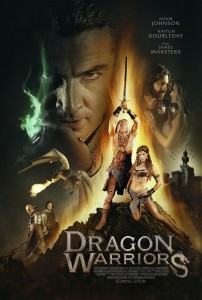 Necromancers, Dragons, and Godzilla, oh my!
Necromancers, Dragons, and Godzilla, oh my!
Once again I violate my rule about posting Kickstarter campaigns here… Well, okay, it’s more of a guideline than a rule. An intention, maybe. A fuzzy goal? Well, whatever, my usual warnings apply… they may not ever deliver on their promise, participate at your own risk, etc.
In this case, it’s a couple of movies that have been filmed locally. I know the guy who runs Arrowstorm Entertainment (I worked with him … or, I guess, indirectly for him… when I worked on the SAGA MMO), and do like Kevin Sorbo and James Marsters. And comedic fantasy. In the Kevin Sorbo film, Mythica, I thought it resembled what the Dungeons & Dragons movie should have been. And, well, James Marsters is a pretty cool, genuine guy. And he plays a good villain. And… well, somebody’s gotta make the B-movies, right? Actually, compared to the crap I used to watch back in the 80s, these both look pretty awesome. So I’m glad these guys are helping to make sure my children and grandchildren don’t have to go back and watch stuff like Beastmaster, or Ator the Fighting Eagle, or Sorceress, or Yor: Hunter from the Future ever again. (Apologies to people who love those movies. It takes all kinds, and I know those have their fans. My wife absolutely loves Hawk the Slayer; I do not understand why. But apparently it’s a cult favorite among gamers, which makes me the odd man out…)
Anyway, these films have already been shot, but they need the money for all the CG and post-production goodness. They only have a few days left, and are pretty close to their goals… I think it’s unfortunate they both launched their Kickstarters at the same time, but… them’s the breaks, sometimes. I think they both used Salt Lake Comic Con FanX to launch their Kickstarters, so that’s why they are both going simultaneously. Anyway, they only have until the end of the week, so now’s the time to pledge if you are so inclined.
First off… Mythica. This one is not quite at their funding level yet, but is really close, and 90% likely to make it. And as much as I like James Marsters, this is probably the better of the two (and again, I know – kinda – the Arrowstorm guys and they have been steadily improving and doing good work)… And this is hardly their first Kickstarter. They have a pretty good track record of delivering.
Not that it impacts me, but I love this FAQ for Mythica:
Q: Will the DVDs/BluRays be Region Free?
A: Yes. Always. We think DRM is stupid.
Next is Dragon Warriors, starring James Marsters and some lesser-known actors, by Main Dog Productions- but they are also in co-production with Arrowstorm. The entire show was filmed against a green screen, so yeah… they’ve got a crapload of CG to do. I’m not sure what Arrowstorm is bringing to the table, but again, they have a track record, so that helps reduce the risk.
Dragon Warriors on Kickstarter
And the bonus round… a Rifftrax Live event on Kickstarter. It barely started, and is already nearly funded. They want to riff the 1998 dud, Godzilla (the one with Matthew Broderick), in theaters. The rights are kind of on the expensive side, so… well. I’ve been to a couple of Rifftrax “Live” events (Manos: The Hands of Fate, and Plan 9 From Outer Space), and they’ve been great fun. If you are a fan of the old show Mystery Science Theater: 3000, then you know these guys and what they do. More or less.
Rifftrax Live: Godzilla, in theaters — on Kickstarter
All I can say is that I went into the movie theater in 1998 saying to my wife and co-workers who joined us to see the film, “It’s Godzilla. Giant lizard eats major city. It’s impossible to screw up. I’m sure I’ll enjoy this.” Then, a couple hours later, I left the theater saying, “I can’t believe it. They actually screwed it up. I want those two hours back.” So… I hope this pans out, because I’d consider a solid riffing on this movie the best way possible to redeem that particular disappointment.
There! I promise not to post any more Kickstarters on here, until the next time at least… 🙂 But I did want to point these out to you folks, as they might strike your fancy.
Filed Under: Movies - Comments: 3 Comments to Read
Terra Mechanica – Coming Soon!
Posted by Rampant Coyote on May 12, 2014
 Well, folks, it’s not Frayed Knights 2, but one of my latest projects is getting released in a few days –
Well, folks, it’s not Frayed Knights 2, but one of my latest projects is getting released in a few days –
Terra Mechanica: A Steampunk Anthology
I was kinda surprised how many long hours went into a short story. I thought it would be a lot easier working with a publisher to handle all the crap (especially stuff I don’t really know how to do in the book publishing world), but it turns out there’s a lot more to do after the contract is signed.
Still, this was a lot of fun, and I was excited to try and exercise my writing in a non-interactive format. I expect I’ll keep up the writing on the side… in addition to game development… and blogging… and the day job… Hmmm. I wonder if I really need all five hours of sleep every night?
Anyway, I’m reading through the advanced reader copy now, and I’m enjoying the other stories in the anthology (which I only knew by title before). Fun stuff, if you are into steampunk. Actually, I was a little worried that my own story might be a little too light on the steampunk side of things, but the stories have so far run the gamut. One is much more of a straight-up fantasy set after the U.S. Civil War, except for the inclusion of a mechanical companion. Another (Pete Ford’s story, ‘The Voyage of Valerie McGrath’) resembles vintage sci-fi to me … with the exception that the flying ships over an alien planet have “clockwork” autopilots rather than computers. So even if you aren’t really into pure ‘steampunk’ (as if such a thing existed), there’s a nice variety of speculative fiction.
My own story is entitled “Dots, Dashes, and Deceit.” It’s about a recently unemployed telegraph operator and a mute savant who discover a secret plot encoded within innocent-sounding telegraph messages. It was inspired while I was doing research for a totally different story idea, and learned that a lot of what I thought was science-fiction technology in 1880 actually existed. It might not have been in common use, but international cables, fax machines, and of course the telephone were all invented and in use at the time. Things like online romance, telecommunications fraud, identity theft, and all that jazz that we think are artifacts of the Internet age were actually present a hundred years earlier.
So I ended up with a very different story, revolving around Morse code and telegraphy. And of course, villainous international corporations, airships, and mechanical men. Because steampunk! And it’s just plain fun.
Anyway, I’m extremely excited for the book (naturally)! It will be available via Amazon in print and popular ebook formats on May 31.
Filed Under: Books - Comments: 4 Comments to Read
The Revolution – And Unreal Tournament – Will Be Televised
Posted by Rampant Coyote on May 9, 2014
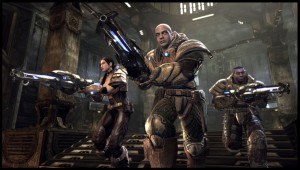 I gotta hand it to Epic – even when they go “small,” they go big. First it was with totally re-pricing the new Unreal Engine so that it was affordable to small indies. And now, they are making the development of their next game in their flagship series, Unreal Tournament, as completely open as they can short of openly inviting the public to come physically hang out inside their office.
I gotta hand it to Epic – even when they go “small,” they go big. First it was with totally re-pricing the new Unreal Engine so that it was affordable to small indies. And now, they are making the development of their next game in their flagship series, Unreal Tournament, as completely open as they can short of openly inviting the public to come physically hang out inside their office.
The Future of Unreal Tournament
So basically, it’ll be open development – all code released to UE4 licensees as it is developed, discussions in the open with fans about where the game is going to go, just… open. To top it all off, when the game is completed it will be released completely free to the public. Not “free to play” as in “a demo version,” but completely without charge. However, they will be setting up a “marketplace” to buy and sell mods and content, with Epic taking a percentage of the revenue.
Obviously, this is a pretty audacious move sure to grab tons of publicity, not to mention goodwill. Probably even more importantly, it serves as a giant tutorial to show inexperienced and potential UE4 developers how “the big boys do it,” showing how an internal development team uses the engine. And, finally, it’s a high-profile way to get started on a marketplace that will compete with Unity’s Asset Store in the future. Not to mention having tons of DLC created by third parties that they get to profit from.
Honestly, as much as I want to be cynical and jaded about this (and I’m sure that a lot of this is driven by the harsh realities of the changing AAA game marketplace), I just can’t help but be impressed. We’ll see how it evolves, but as of right now it sounds like a brilliant move. Those who want a peek into the sausage factory, and a hand (well, a fingertip) in guiding the game can participate. Everyone else… which will probably include me… will simply feel warm fuzzies about the company that seems to “get it” and is – as was Interplay’s motto back in the day – “by gamers for gamers.”
Filed Under: Biz, Game Development, Mainstream Games - Comments: Read the First Comment
Make Millions Making Games Without Actually Making Games*
Posted by Rampant Coyote on May 8, 2014
There’s a saying in games development that a game is never truly finished, merely shipped. What that really means is that perfection is unattainable, and every game ships with more things the developers would like to do. But eventually, the game has to go out, and whether or not it’s “good enough” is left to the marketplace to decide.
At least, that’s how it worked in the bad old days. Nowadays, with “alpha-funding” and crowdfunding, game developers have the opportunity to sell empty promises to consumers, and then pull the plug after they’ve literally made millions selling a tech demo.
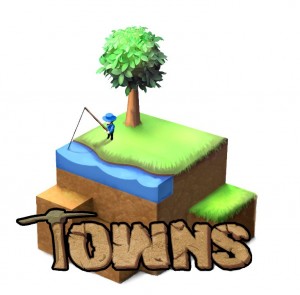 Don’t say I didn’t warn you…
Don’t say I didn’t warn you…
Alpha-Funded Steam Game Towns Abandoned By Developers
There are a couple of complications in this story. It wasn’t officially marked as an “early release” on Steam (but it was elsewhere, like Desura), and the guy stuck with finishing development was apparently clueless and incompetent, while the original developer ran off the the bulk of the cash. But no matter how you slice it… the customers were screwed. They were told they were buying one thing, fed promises of what they would eventually be playing, and …. they ain’t ever gonna see it.
To add insult to injury, the remaining developer – who has apparently not been able to produce much over the last several months – is suggesting making a “sequel” that players will have to purchase all over again that might contain all of what they originally promised with the first product.
This is perilously close to scam territory. Probably unintentional. In my experience, most first-time indie projects never make it to release. They get the “easy” 80% of the project done (which is, apparently, enough to start selling the game in today’s world), but the last 20%… which actually takes the lion’s share of the effort … is beyond their ability.
In addition, in the case of pre-selling the game, where the bulk of sales happen in the first few weeks after launch… that means the hardest part of development will occur when the game is already in its “long tail.” What’s the motivation to keep going on a game when the money is already spent and there’s not much more to look forward to? When it would be far more profitable to move on to the next game?
I hope this shakes some common sense into people, but in all likelihood any revelations will probably just be misdirected anger and distrust towards all of indie gaming. Or maybe just towards all customer-funded development.
I haven’t always followed my own advice. I’ve picked up a few early release games (most part of bundles), and there have been a couple of them that have since apparently lost all developer support. I’m left with little more than a rough tech demo. Granted – these are exceptions to the rule. And I have several games I’ve pre-ordered / crowd-funded / gotten early access to which have turned out pretty awesome. But these exceptions are not uncommon.
Simply put, do not buy anything based on promises unless you have reason to have faith in the ability and commitment of the seller to follow through. That’s basic and universal and applicable through any time period, culture, and technology. I think this kind of thing is going to keep happening until both customers and would-be developers get an understanding of just how challenging making a complete, commercial-quality game can be.
* At least to the point of anything completion
Filed Under: Biz - Comments: 9 Comments to Read
“Valence Electrons, First-Person Shooter”
Posted by Rampant Coyote on May 7, 2014
I vaguely remember high school chemistry. I remember working out the formulas, figuring out how you got molecules sharing electrons or whatnot. I guess I better remember the term “covalent bonds” rather than really understanding what it means. It’s been a while.
So, sadly, I haven’t been much help with my daughter’s homework for that class. Brenna has been on her own… and doing pretty well, apparently. I guess she’s got a better head for chemistry than either of her parents. That’s pretty awesome.
But – finally – I had the chance to help her out. They had a project in the class to create a game based around principles learned in one of their units covered this year. Or – I guess – to adapt a game / game style to reinforce principles learned in class. Something like that. Anyway – Brenna asked for my help. She wanted to do something different from everybody else. She wanted to turn it into a video game.
So we worked together on it. She had to come up with the questions, and did some of the art. I threw together bits and pieces of content packs and tools that I had to create a game in Unity. I can’t say this is ready for prime-time or anything like that, but on the plus side – I began to memorize the valence levels of various atoms as I tested the game, so that’s something… 🙂
Anyway, the students were all supposed to set up their game, announce the unit they were covering, and what kind of game it was. So they were saying things like, “The Periodic Table, Bingo,” and “Covalent Bonds, Jeopardy.” It got to Brenna’s turn, standing beside her laptop, and she announced:
“Valence Electrons, First-Person Shooter.”
Well, it sounds like it was kind of a hit in the chemistry class. Kids were lining up to play. Not everyone got a chance to play in her class period, but the teacher kept the games up each period, and apparently the entire 8th period class played the game.
From a gameplay perspective, it… well, as a gamer, it kinda sucks. Originally I had envisioned more active enemies, moving around and shooting back as you missed them or got the wrong answer. But not only did we not have enough time, but with the time limit in place, I thought it would distract from the real point of the game. Someone who knew their valence electrons shouldn’t lose the game or get a bad score because their first-person shooter skills aren’t up to snuff.
So the gameplay serves the purpose of the game, as a mildly entertaining educational tool. That’s probably a definition of good gameplay right there. At least, that’s my story and I’m sticking to it. I did randomize the enemy’s atomic signature so that players couldn’t just memorize the order of the answers. Brenna and I both wanted the doors to vary the action a little bit, and to ask some more interesting questions.
The 3D Sprite code… I’m not familiar with anything in stock Unity to do this, but it was ridiculously easy to code. All you have to do is a call to set the facing of the visual in the direction of the player. We did that because I really didn’t want to try and make 3D models based on Brenna’s artwork. Hey, it worked for Doom…. 🙂
The game is played first-person shooter style… you use the WASD controls on the keyboard to move around. To shoot an enemy with your “electron distributor”, you aim at it with the “X” crosshair, and shoot by pressing the number key equal to the number of valence electrons needed to balance the atom (the symbol above its head). So Xenon (Xe) has 8 valence electrons, so you would aim at an Xe – labeled enemy and press the “8” key to shoot it. Shoot it with the wrong number of valence electrons, and you will lose a health marker. Lose all 5 health markers, and its game over.
To open a door, you need to clear out all the enemies before the door, and then step close to it. You’ll be asked a chemistry question. Answer 1-4. Get the answer wrong, and you’ll lose a health. Get it right, and the door opens.
And there’s a princess at the end of the level. If you get to her, you get a score bonus based on your time (+1 point per second remaining on the clock, up to 120), and +10 points per health remaining. Each enemy defeated is worth 5 points, and doors opened are worth 20.
What? You wanna play it? Are you masochistic? Or are you just good at chemistry?
The game is really not much more than a Game Jam effort, the equivalent of a (looong) day of development. And if you don’t know your periodic table and valence levels, it’s going to be a lot of trial and error (I’ll add a cheat sheet to the comments). But if you want to, you can play it here. You will need the Unity web player (which will automatically be linked to if you don’t have it installed):
Anyway, I feel like I did my duty as a geek game-developer daddy.
Filed Under: Design, Geek Life - Comments: 4 Comments to Read
Belated BASIC Birthday
Posted by Rampant Coyote on May 6, 2014
I didn’t realize that last Thursday was the 50th anniversary of the release of BASIC. Wow. And I thought it was pretty old when I was first introduced to it when I was twelve.
BASIC stands for “Beginner’s All-purpose Symbolic Instruction Code.” But not really. I think they just came up with whatever words fit so that they could be abbreviated BASIC. It was intended to be an easier way to program than assembly language and the few, higher-level languages of the era (like FORTRAN and COBOL). And it was… at least kind-of, if you stuck with the standardized version of the language, fairly cross-platform. But mainly, it was easy-to-learn.
At least in the original specification, it was nice and procedural, with numbered steps. Branching and loops were handled in a fairly intuitive way… “Skip to step (or line) 12,” or “go back to line 5.” Except, of course, we rarely ordered the steps in contiguous numbers like that. This is because – when we inevitably had to edit the code and insert new instructions, most BASIC systems didn’t have a handy-dandy way to re-order everything to insert a new command. Instead, we tended to write programs with steps incremented by 10, like:
10 PRINT “THE RAMPANT COYOTE WAS HERE.”
20 GOTO 10
That would cause an infinite loop of it printing a stupid message over and over again, forever. Admit it, if you ever programmed in BASIC, you wrote something like that at least once. It’s like the next step above “HELLO WORLD.” There was a rush of power in writing that stupid program… the machine would obey you exactly, forever, at least until you used an interrupt sequence or turned the power switch off. If I wrote that program in 1984 and left it going, and suffered no power interruptions and no hardware failures, that computer would still be dutifully printing an endless column of the words “The Rampant Coyote Was Here” today, thirty years later.
My introduction to BASIC was from an incredibly stripped-down interpreter in the Sinclair ZX80 computer – obsolete the day it was released, but unbelievably cheap in its time – and the “BASIC Computer Games” and “More BASIC Computer Games” books edited by David H. Ahl, editor of Creative Computing Magazines. These books were kind of old by the the time I got them, but the games could be used on many different machines (sadly, only the smallest could fit on my ZX80), and they were entirely text-based. But within those limitations, the games were of so many different styles, and by so many different authors, that in studying them I received an education both in game design and in approaches to problem-solving in code. For example, the game space – the “map” so to speak – was handled so many different ways in all of the programs that I really came to understand how to approach data representation differently depending on the needs of the application.
BASIC was how a generation of us learned to program. Oh, we may have started very young with something like LOGO, and we may have moved on to bigger and better things like PASCAL early on… but if you were a young computer geek in the 1980s, BASIC was probably your gateway drug.
It’s silly to compare it to modern programming languages. Even Microsoft’s VisualBasic, which probably extended the life of the language a good ten years beyond its naturally allotted span, can’t really compete in the modern world. I’m not sad that it has been surpassed by better languages, but I am concerned that it doesn’t really have a successor as a “beginner” language. I’ve frequently thought Python might be a worthy heir to the throne, but it hasn’t ever gotten the traction and support. These days, C# seems to be the programming language of choice, and I don’t think it’s that hard to learn, but my vantage point is a long distance from that of an absolute beginner.
But if it weren’t for BASIC, I might still be an absolute beginner. Its virtue was being easy to understand. It was powerful enough for simple games, on the machines of the era. And perhaps it was the single greatest factor in bringing the world of computers out of the lofty heights of the engineering priesthood and into the hands of the common man. Most computers of the 1980s shipped with a copy of BASIC, and with that, the expectation that software creation was expected and encouraged of end users. While programming wasn’t for everybody, it did seem like it was for anybody. At the very least, it was for anybody to take advantage of. After all, anyone could type in some code in BASIC from a printed page in a magazine and suddenly have a checkbook manager, a planetary environment simulation, or a game of checkers. Not as convenient as grabbing a download from the app store, but it also helped demystify the machines.
Nowadays, we use, tote, and even wear computers of unimaginable power compared to those early days when BASIC was first introduced. Computers are far more “personal” than the era when “Personal Computer” was a marketing buzzword. Computers are for everybody. I like to think BASIC had something to do with that.
Filed Under: Programming - Comments: 13 Comments to Read
Texting the Player
Posted by Rampant Coyote on May 5, 2014
I’ve been a fan of text in games since… well, since I discovered the original Colossal Cave Adventure. I’ve actually mourned the slow demise of text in games, although I admit I am sometimes the one who will skip it. I blame lousy writing.
Peter Angstadt has some valuable bits of advice for encouraging players to read text in games.
As I read these, I’m thinking… “Crap. I should really do this.”
And it’s not like I was completely unfamiliar with some of these rules. I based the dialog in Frayed Knights on comic-book style dialog, which frequently used boldface to highlight important words. I knew it, I even thought about doing it, but I didn’t implement it in the first game! My bad. Time to make some changes to the sequel…. 🙂
I think the biggest problem is that the brain goes into different ‘modes’ when it is playing, versus watching, versus reading, and it’s very hard to switch modes in mid-stream. If I’m playing a text adventure (er, Interactive Fiction…) – and yes, I occasionally still do – I have no problem with the text. I enjoy it. I’m in “reading and problem-solving mode.” If I’m playing a 16-bit style JRPG, it’s also pretty easy to read the text. In a game like Skyrim, I have to force myself a little bit, because I’m immersed in a 3D action world and suddenly have to shift gears to reading pages of books or something. And if it’s dialog… honestly, I read the dialog so fast, I usually get impatient with the voice-overs.
I still think text has an important role to play in games. While it’s perhaps not the most “natural” form of communication between human beings, it’s tried and true, and is an extremely flexible medium for communication. I’m in favor of keeping plenty of text in games – at least some kinds of games, although I know some game developers would take issue with that.
Filed Under: Design - Comments: 6 Comments to Read
ZeniMax to Oculus VR: We Own Carmack’s Brain
Posted by Rampant Coyote on May 2, 2014
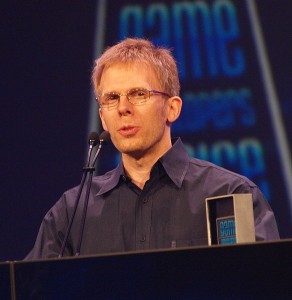 Every once in a while, I do discover that I live in bizarro-world. 2013, in particular, was a very bad year for any American who likes to scoff at conspiracy theories. The tinfoil hat crowd were vindicated way too many times that year. So… yes. Yes, I have to admit that every once in a while, I must recheck what seems obvious and realize that the inconceivable is occasionally fact.
Every once in a while, I do discover that I live in bizarro-world. 2013, in particular, was a very bad year for any American who likes to scoff at conspiracy theories. The tinfoil hat crowd were vindicated way too many times that year. So… yes. Yes, I have to admit that every once in a while, I must recheck what seems obvious and realize that the inconceivable is occasionally fact.
So in this bizarro-world, I suppose it is possible that John Carmack, one of the greatest programming minds of our generation, actually swiped property from his former place of employment to plug into what he intended to do at Oculus VR as their CTO, because he didn’t feel confident starting over from scratch with that really hard programming stuff, and really, REALLY needed some reference code…
… I mean besides the reference code he’s already released into the public domain from his past software development at id Software, because he could rewrite all that crap in his sleep, and better optimize it by breakfast the next day.
ZeniMax, the owner of game studios Bethesda (Elder Scrolls series) and id (Doom, Quake, Rage, etc.) is making the claim that “the proprietary technology and know-how Mr. Carmack developed when he was a ZeniMax employee, and used by Oculus, are owned by ZeniMax.”
Carmack has countered that he never patented anything he created at id Software (true story – he’s a vehement opponent of the practice) and that Oculus does not use a single line of code he developed while at Zenimax.
I’ve had to sign non-competes before. I’ve always modified them, because they are usually pretty stupidly broad. Their legal justification (which they really have to work at in a right-to-work state like Utah) is always that the company provides the employee with proprietary skills and knowledge that they must protect from being obtained by a competitor. A friend of mine – my boss at a network marketing company – refused to sign it at all, because they originally hired him in order to obtain his expertise. He’d been working in the field for years, and they desperately needed someone of his skills to help them get off the ground software-wise.
I don’t know what Carmack signed when he allowed id Software to be bought out by ZeniMax, but it sounds like a very similar situation. Frankly, he’s the guy who brought the expertise to the party. Accusing him of stealing “proprietary technology and know-how” is about like accusing Mozart of “stealing notes” to be used in other musical compositions.
 Again, I find that I sometimes live in bizarro world, so I can’t completely dismiss the claim, but I find it pretty laughable. Sure, Carmack worked on some prototype VR technology while at ZeniMax. To me, unless they can prove that he’s using code developed on company time at ZeniMax, they don’t have a leg to stand on, and I hope they get smacked down hard in a counter-suit for being such dickweeds about it. The best they can try and claim is that he’s somehow in violation of a non-compete clause in his contract, but that’s not what they seem to be claiming.
Again, I find that I sometimes live in bizarro world, so I can’t completely dismiss the claim, but I find it pretty laughable. Sure, Carmack worked on some prototype VR technology while at ZeniMax. To me, unless they can prove that he’s using code developed on company time at ZeniMax, they don’t have a leg to stand on, and I hope they get smacked down hard in a counter-suit for being such dickweeds about it. The best they can try and claim is that he’s somehow in violation of a non-compete clause in his contract, but that’s not what they seem to be claiming.
As much as companies would prefer otherwise, slavery has been outlawed since 1863 in this country. And no, you can’t lay claim to their brain, either. If you don’t want your employees to walk, you have to keep them happy. And sometimes that won’t work, either, because they just want to try different things. That’s the way it’s supposed to work in the free market. Tough toenails.
Unless they have proof that Carmack stole code or patented technology (and I can’t imagine him doing either), this sounds like nothing more than business as usual. I’m truly frightened by the prospects of life in the tech sector in the U.S. in the 21st century if ZeniMax pulls this off.
Filed Under: Biz - Comments: 4 Comments to Read
Zombie Apocalypse, Fantasy Style?
Posted by Rampant Coyote on May 1, 2014
Steven Peeler is requesting feedback on his new game concept – the fifth game from Soldak Entertainment:
http://www.soldak.com/Blogs/St
I thought I’d pass this along and let folks answer him. He’s changing things up a bit this time, announcing things and soliciting feedback much earlier in the process than usual. This means that a lot could change, and this might not actually end up being the fifth game after all. It’s up in the air. But hey, one of the cool things about being an indie is that you can make your own rules.
The only commentary I’ll add here is that I’m a big fan of Soldak’s games. While Kivi’s Underworld wasn’t my favorite, I’ve loved everything else he’s come out with. I’m sure the next one will be awesome.
Filed Under: Game Announcements - Comments: Comments are off for this article
Greenlight Follies
Posted by Rampant Coyote on April 30, 2014
Frayed Knights: The Skull of S’makh-Daon is finally in the top 100 games on Steam Greenlight.
I could use everyone’s help to move it up and – more importantly – keep it there. I suspect just about everyone who hits this blog and who has a Steam account has already voted for it (or has politely not commented on how much they really dislike my game), but if you haven’t yet – or if you have a friend who can be talked into helping out a niche game by a guy who sucks at marketing. At this point, getting on Steam is probably not the gateway to wealth and status that it once was for a poor indie developer, but it does help.
Also – Aldorlea Games, run by a friend of mine, finally got a game on Steam – the first of the Millennium games. If you’ve ever been inclined to check out this jRPG-style game but haven’t yet, or were waiting for it to come out on Steam, now’s the time. Millennium: A New Hope is discounted 20% for its Steam debut.
Filed Under: Frayed Knights - Comments: 7 Comments to Read
E.T. Exhumed from New Mexico Desert
Posted by Rampant Coyote on April 29, 2014
 I suppose everyone has heard about this by now. I was knee-deep in getting this website put back together, and even I heard about it over the weekend. I’d heard it was happening a couple of weeks ago, but then promptly forgot about it. It seems Microsoft and others got permission to exhume (and document) one of more famous landfills of all time – the one where, according to legend, millions of E.T. Cartridges for the Atari 2600 were buried.
I suppose everyone has heard about this by now. I was knee-deep in getting this website put back together, and even I heard about it over the weekend. I’d heard it was happening a couple of weeks ago, but then promptly forgot about it. It seems Microsoft and others got permission to exhume (and document) one of more famous landfills of all time – the one where, according to legend, millions of E.T. Cartridges for the Atari 2600 were buried.
Atari E.T. Cartridges Unearthed in New Mexico Desert
I was a gamer back then, though I never owned an Atari 2600. I played it at a friend’s house. Well, lots of friends’ houses. I was pretty jealous of it until I got my Commodore 64. I’d heard the same stories. As the legend goes, Atari was in a world of hurt, and E.T. was something of a “hail mary” play for them. They actually produced more cartridges than the install base of consoles – on the theory that the mega-hit movie license would revive the flagging sales of the machine. It failed, and the game was a disaster. In a show of spite (at least to the ears of gamers who heard the story), they covered it with a slab of concrete.
At the time, we accepted it as Truth. It was a couple of decades later before doubt began to be cast on the story.
 Now, it seems, the legend was at least essentially true. Atari had written off a good chunk of their inventory for tax purposes as the business was collapsing, and had to dispose of it – something like three-quarters of a million unsold game cartridges (rather than millions). It wasn’t just E.T. cartridges either – although that made up a good chunk of the unsold inventory. But when stories of kids sneaking into the dangerous landfill at night and scavenging game cartridges came to light, they decided to pour concrete over the dump site and seal it off. Forever…
Now, it seems, the legend was at least essentially true. Atari had written off a good chunk of their inventory for tax purposes as the business was collapsing, and had to dispose of it – something like three-quarters of a million unsold game cartridges (rather than millions). It wasn’t just E.T. cartridges either – although that made up a good chunk of the unsold inventory. But when stories of kids sneaking into the dangerous landfill at night and scavenging game cartridges came to light, they decided to pour concrete over the dump site and seal it off. Forever…
… Or at least until last weekend.
Considering the state of the cartridges, I don’t know if you’d call it a “treasure trove” of lost games or anything. For those who don’t remember – the business had gone so far south that these cartridges were being discounted down to… well, not quite as cheap as your average iPhone game, but down to less than the cost to manufacture and distribute the cartridges. At the time, the U.S. at least was saturated by the game console and its cartridges. It was 1970s technology, and hotter tech was not only on the horizon, but it was already here. While an exclusive game license might slow its descent in the marketplace, its fall was already mature and inevitable.
But after thirty years, it does take a little bit of the flavor of an archeological dig. Maybe not an ancient one, as some of the people responsible for it were there for the exhumation, but certainly one of historical interest to some of us. It’s also more than a little sad, as I remember seeing these boxes in pristine shape on the store shelves.
 Apparently, they are making a documentary of this event, which will be cool to see when its done.
Apparently, they are making a documentary of this event, which will be cool to see when its done.
And what about the people calling E.T. the “worst game of all time?” I dunno. I’ve seen some pretty bad games in my time. At least a few people think its reputation is unearned, and one guy (?) has made an effort to “repair” the game and make it more playable. There’s seriously only so much you can pack into 4K, but the article was enough for me to revise my view of E.T. (which I didn’t really hate… I was just bored when I played it, and frustrated when I fell into the pits). I haven’t played this “improved” version, but if you have Stella or some other Atari 2600 emulator, you can give it a shot.
It’s pretty cool, 32 years later, to learn the truth about one of gaming’s best-known legends. Now if we could only uncover the truth behind Polybius! 😉
Filed Under: Geek Life, Retro - Comments: 4 Comments to Read
